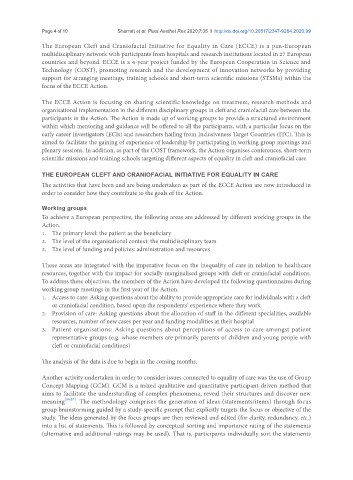Page 384 - Read Online
P. 384
Page 4 of 10 Sharratt et al. Plast Aesthet Res 2020;7:35 I http://dx.doi.org/10.20517/2347-9264.2020.99
The European Cleft and Craniofacial Initiative for Equality in Care (ECCE) is a pan-European
multidisciplinary network with participants from hospitals and research institutions located in 27 European
countries and beyond. ECCE is a 4-year project funded by the European Cooperation in Science and
Technology (COST), promoting research and the development of innovation networks by providing
support for arranging meetings, training schools and short-term scientific missions (STSMs) within the
focus of the ECCE Action.
The ECCE Action is focusing on sharing scientific knowledge on treatment, research methods and
organisational implementation in the different disciplinary groups in cleft and craniofacial care between the
participants in the Action. The Action is made up of working groups to provide a structured environment
within which mentoring and guidance will be offered to all the participants, with a particular focus on the
early career investigators (ECIs) and researchers hailing from Inclusiveness Target Countries (ITC). This is
aimed to facilitate the gaining of experience of leadership by participating in working group meetings and
plenary sessions. In addition, as part of the COST framework, the Action organises conferences, short-term
scientific missions and training schools targeting different aspects of equality in cleft and craniofacial care.
THE EUROPEAN CLEFT AND CRANIOFACIAL INITIATIVE FOR EQUALITY IN CARE
The activities that have been and are being undertaken as part of the ECCE Action are now introduced in
order to consider how they contribute to the goals of the Action.
Working groups
To achieve a European perspective, the following areas are addressed by different working groups in the
Action.
1. The primary level: the patient as the beneficiary
2. The level of the organisational context: the multidisciplinary team
3. The level of funding and policies: administration and resources
These areas are integrated with the imperative focus on the inequality of care in relation to healthcare
resources, together with the impact for socially marginalised groups with cleft or craniofacial conditions.
To address these objectives, the members of the Action have developed the following questionnaires during
working group meetings in the first year of the Action.
1. Access to care: Asking questions about the ability to provide appropriate care for individuals with a cleft
or craniofacial condition, based upon the respondents’ experience where they work
2. Provision of care: Asking questions about the allocation of staff in the different specialities, available
resources, number of new cases per year and funding modalities at their hospital
3. Patient organisations: Asking questions about perceptions of access to care amongst patient
representative groups (e.g. whose members are primarily parents of children and young people with
cleft or craniofacial conditions)
The analysis of the data is due to begin in the coming months.
Another activity undertaken in order to consider issues connected to equality of care was the use of Group
Concept Mapping (GCM). GCM is a mixed qualitative and quantitative participant-driven method that
aims to facilitate the understanding of complex phenomena, reveal their structures and discover new
meaning [26,27] . The methodology comprises the generation of ideas (statements/items) through focus
group brainstorming guided by a study-specific prompt that explicitly targets the focus or objective of the
study. The ideas generated by the focus groups are then reviewed and edited (for clarity, redundancy, etc.)
into a list of statements. This is followed by conceptual sorting and importance rating of the statements
(alternative and additional ratings may be used). That is, participants individually sort the statements

